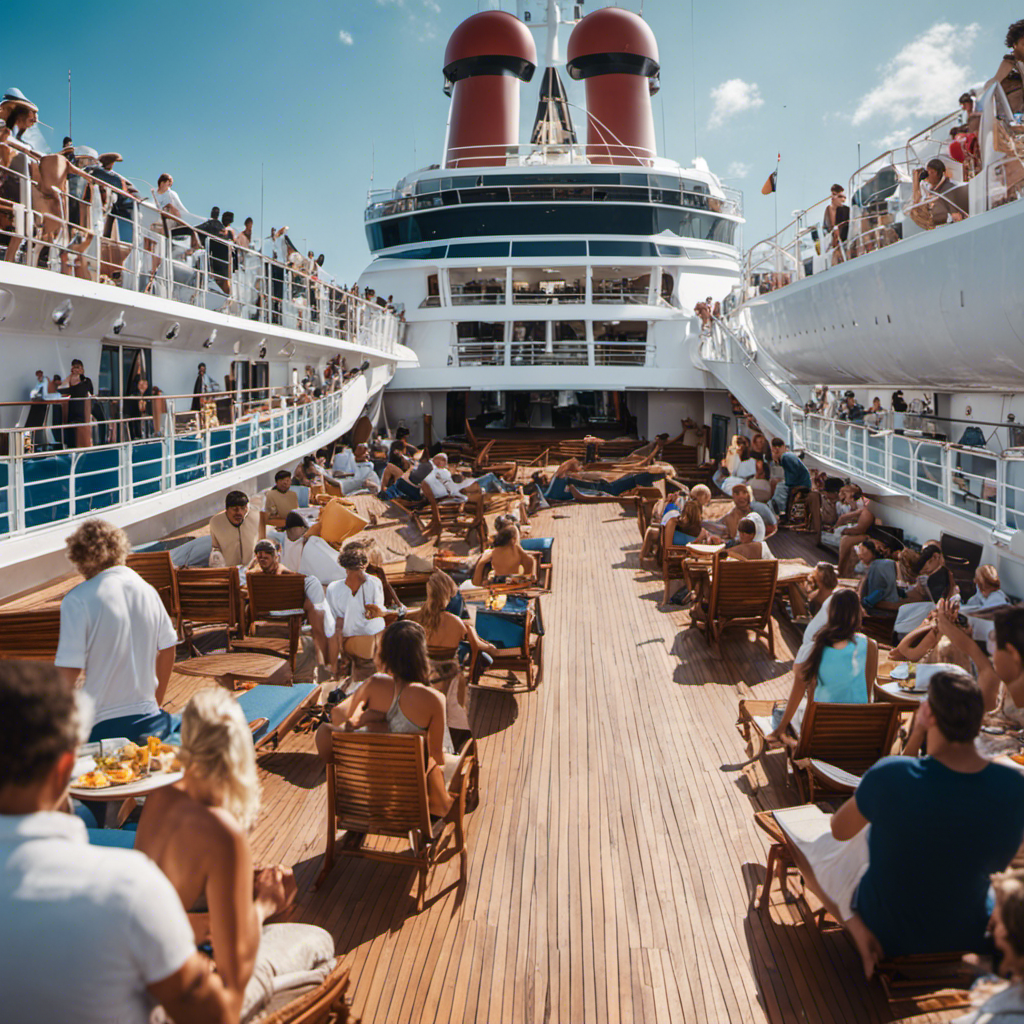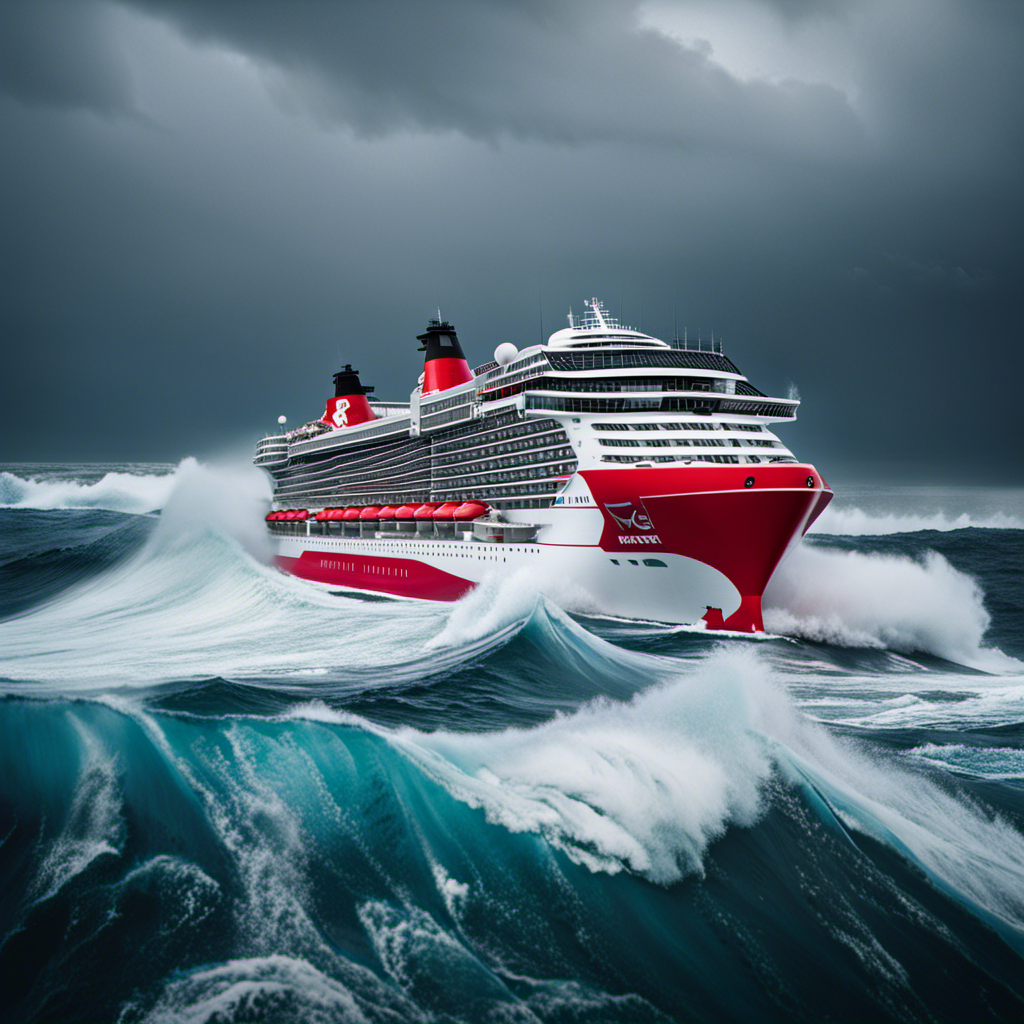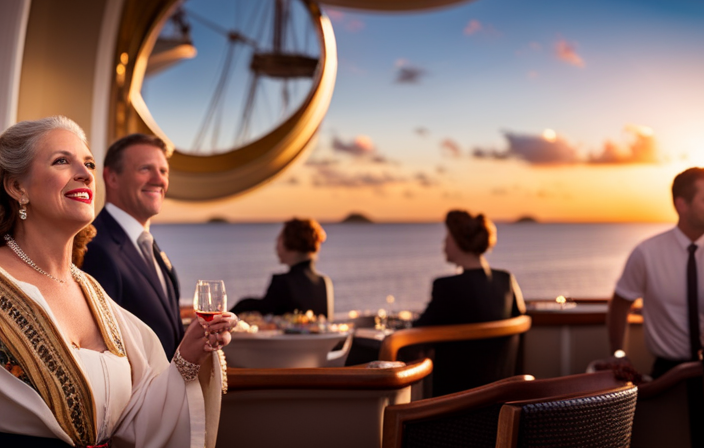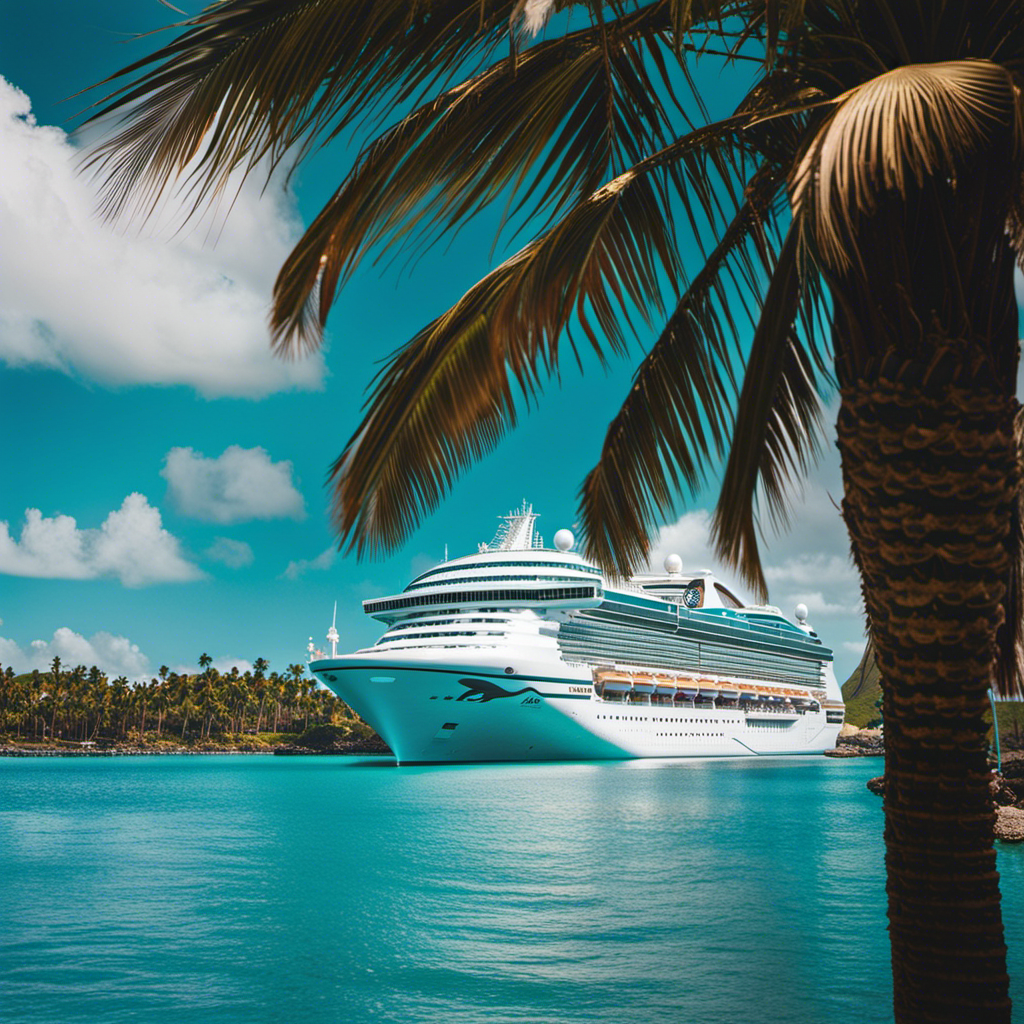Did you know that an average cruise ship can house thousands of passengers? Yes, it’s true!
In fact, the number of people on a cruise can vary greatly depending on factors such as cabin occupancy rates, crew size, and the popularity of the cruise line.
In this article, we will explore all these aspects and more to give you a comprehensive understanding of just how many people are on a cruise.
So, sit back, relax, and let’s embark on this fascinating journey together!
Key Takeaways
- The passenger capacity of cruise ships can vary greatly, with smaller ships accommodating a few hundred passengers and larger ships hosting several thousand passengers.
- Factors such as the size of the ship, passenger demographics, popular destinations, and special events/promotions all impact the number of people on board.
- Cabin occupancy rates depend on the size of the ship, popularity of destinations, and the number of booked cabins.
- Crew size plays a crucial role in ensuring a smooth voyage, with the crew-to-passenger ratio varying based on ship size. Efficient management of crew size is crucial for efficiency and passenger satisfaction.
Average Passenger Capacity on a Cruise Ship
On average, a cruise ship can accommodate around 2,500 passengers. The number of passengers on a cruise ship can vary depending on the size and design of the ship. Some smaller ships may only accommodate a few hundred passengers, while larger ships can host several thousand.
The average passenger demographics on a cruise ship also play a role in determining the number of people on board. Cruises cater to a wide range of age groups, from families with children to retirees, and offer various activities and amenities to suit different interests.
The impact of these passengers on local economies is significant. When a cruise ship docks at a port, passengers often spend money on excursions, shopping, and dining, boosting the local economy. This economic impact is one of the factors affecting the number of people on a cruise.
Factors Affecting the Number of People on a Cruise
The number of individuals aboard a cruise ship can be influenced by various factors. These factors include:
-
The size of the cruise ship: Larger ships have the capacity to accommodate more passengers, while smaller ships have a more intimate atmosphere.
-
Cruise ship demographics: Different cruise lines cater to different age groups and interests. Some ships may attract families with children, while others may target older adults or singles.
-
Cruise ship itineraries: The popularity of certain destinations or routes can impact the number of passengers onboard. For example, a cruise ship that visits popular tourist destinations like the Caribbean or Mediterranean may have more passengers compared to a ship with a less popular itinerary.
-
Special events or promotions: Cruise lines often offer special events or promotions to attract more passengers. These can include themed cruises, discounted rates, or exclusive onboard activities.
Understanding these factors is crucial in determining the number of people on a cruise ship and can help in analyzing cabin occupancy rates.
Understanding Cabin Occupancy Rates
To understand cabin occupancy rates, it’s important to consider two factors: the size of the ship and the popularity of the destinations it visits. Cruise ship occupancy rates depend on the number of booked cabins available. The larger the ship, the more cabins there are for occupancy.
Another factor that affects cabin occupancy rates is the popularity of the destinations the ship visits. If a ship is heading to highly sought-after destinations, more passengers are likely to book cabins, resulting in higher occupancy rates. Conversely, if a ship is visiting less popular destinations, there may be more cabin availability and lower occupancy rates.
Now, let’s move on to the next aspect of understanding cruise ship occupancy: the size of the ship’s crew.
Cruise Ship Crew Size
Don’t forget to consider the impact of the crew size on your cruise ship experience. The number of crew members on a cruise ship plays a crucial role in ensuring a smooth and enjoyable voyage. Let’s analyze the crew size and their responsibilities in a three-column, four-row table:
| Role | Responsibilities | Number of Crew Members |
|---|---|---|
| Captain | Overseeing navigation, ensuring safety, and making important decisions | 1 |
| Hospitality | Managing guest services, including dining, entertainment, and housekeeping | Varies |
| Engineering | Maintaining and repairing the ship’s systems, such as propulsion, electricity, and plumbing | Varies |
| Medical | Providing medical care to passengers and crew, managing the ship’s medical facilities | Varies |
Understanding the crew size analysis and their respective responsibilities helps paint a clearer picture of the behind-the-scenes operations that contribute to a memorable cruise experience. Now, let’s delve into the passenger-to-crew ratio on cruises, which further impacts the quality of service and overall satisfaction onboard.
Passenger-to-Crew Ratio on Cruises
When it comes to maximizing passenger satisfaction levels on a cruise ship, one key factor to consider is the optimal crew size.
The crew plays a crucial role in providing excellent service and ensuring the smooth operation of various onboard amenities and activities.
Optimal Crew Size
You should consider the optimal crew size for a cruise to ensure smooth operations and exceptional service. Crew size management is crucial for optimal crew efficiency, as having too few crew members can lead to overworked staff and compromised service quality, while having too many can result in inefficiency and increased costs. To help you understand the importance of crew size, here is a table showcasing the ideal crew-to-passenger ratio for different cruise ship sizes:
| Cruise Ship Size | Recommended Crew Size |
|---|---|
| Small (100-500 passengers) | 1:3 |
| Medium (500-2000 passengers) | 1:4 |
| Large (2000+ passengers) | 1:5 |
Passenger Satisfaction Levels
To gauge passenger satisfaction levels, it’s important to collect feedback through surveys and reviews. This valuable information helps cruise lines identify areas of improvement and deliver exceptional customer experiences.
Based on passenger feedback and customer satisfaction data, here are some key factors that contribute to a positive cruise experience:
- Friendly and attentive staff who go above and beyond to meet passenger needs.
- Well-maintained and clean facilities that create a comfortable and enjoyable environment.
- Diverse and high-quality onboard entertainment options to cater to different preferences.
- Delicious and varied dining options that cater to different dietary requirements and preferences.
- Smooth embarkation and disembarkation processes that minimize stress and waiting times.
By taking these factors into account, cruise lines can continuously strive to enhance passenger satisfaction and provide exceptional cruise experiences.
Now, let’s transition to the subsequent section about peak season crowds on cruise ships.
Peak Season Crowds on Cruise Ships
During peak season, it’s important to consider the crowds on cruise ships. The demand for cruises is at its highest during this time, resulting in larger passenger numbers. With more people on board, it’s inevitable that there will be longer wait times for various activities and amenities.
The lines for dining, entertainment, and even disembarkation can be considerably longer during peak season. It’s advisable to plan ahead and make reservations for popular activities to avoid disappointment. However, cruise lines are well aware of the increased demand and strive to manage it efficiently. They often implement strategies such as staggered dining times and advanced booking systems to minimize wait times.
Despite the larger crowds, many passengers still enjoy their cruise experience, as the ships are designed to accommodate the peak season demand.
Moving on to off-season passenger numbers…
Off-Season Passenger Numbers
When it comes to off-peak travel, understanding the statistics is crucial. Not only does it provide insight into the impact on the cruise industry, but it also highlights the potential cost savings for travelers.
Off-Peak Travel Statistics
You won’t believe how few people choose to travel during the off-peak season on cruises. Despite the popularity of cruise ships in the travel industry, there is a noticeable trend of lower passenger numbers during certain times of the year. This has a significant impact on the cruise industry as a whole. Here are some off-peak travel statistics that highlight this trend:
| Off-Peak Travel Statistics | Passenger Numbers |
|---|---|
| January | 50,000 |
| September | 45,000 |
| November | 40,000 |
| December | 55,000 |
As you can see from the table, there is a decline in passenger numbers during these off-peak months. This can be attributed to various factors such as unfavorable weather conditions or the preference of travelers to vacation during peak seasons. Nevertheless, the impact on the cruise industry is significant, leading to reduced revenues and lower occupancy rates for cruise lines. This emphasizes the importance of attracting more travelers during the off-peak season to ensure the sustainability and profitability of the cruise industry.
Impact on Cruise Industry
Off-peak travel statistics reveal a significant impact on the cruise industry, affecting both tourism and economic implications.
During off-peak periods, the cruise industry experiences a decline in the number of people on board, resulting in reduced revenue for cruise companies and local economies. This decline in passenger numbers directly affects the tourism industry, as fewer visitors mean less spending in ports of call and a decrease in local businesses’ profitability. Moreover, it can have a ripple effect on the entire local economy, including hotels, restaurants, and transportation services.
The economic implications are far-reaching, as job opportunities may be limited, and overall economic growth can be hindered. However, this situation also presents an opportunity for cost savings for travelers.
Cost Savings for Travelers
Traveling during off-peak periods can offer travelers the chance to save money on their expenses. There are several cost-cutting strategies that can make a cruise more budget-friendly.
First, booking in advance can often result in discounted rates. Additionally, opting for a shorter cruise or a less popular itinerary can also help reduce costs. Another way to save money is by choosing an inside cabin instead of a balcony or suite. While it may lack a view, it can significantly lower the overall cost of the trip.
Taking advantage of onboard promotions and discounts, such as drink packages or specialty dining deals, can further stretch your budget. By implementing these cost-cutting strategies and choosing budget-friendly cruise options, travelers can enjoy a memorable vacation without breaking the bank.
Transitioning to the subsequent section about solo travelers on cruises, it is important to note that traveling alone can be a great option for those seeking a unique experience.
Solo Travelers on Cruises
There’s a growing number of solo travelers on cruises these days. As someone who has experienced cruising alone, I can attest to the many benefits it offers. Here are three reasons why cruising solo can be a fantastic experience:
-
Freedom and Independence: Traveling alone allows you to set your own schedule and do whatever you please. You can explore the ship and its amenities at your own pace, without having to worry about accommodating others.
-
Meeting New People: Cruises provide a perfect environment to meet fellow travelers from all over the world. From group activities to social events, you’ll have plenty of opportunities to make new friends and create lasting memories.
-
Relaxation and Reflection: Solo cruising offers a unique chance to disconnect from the outside world and focus on self-care. Whether you want to unwind in the spa, read a book on the deck, or simply enjoy the breathtaking ocean views, cruising alone allows you to prioritize your own well-being.
Speaking of cruising, it’s interesting to note the maximum passenger capacity of popular cruise lines.
Maximum Passenger Capacity of Popular Cruise Lines
When it comes to cruise ship occupancy rates, it’s fascinating to see the variety of passenger demographics on board. Different cruise lines cater to different types of travelers, resulting in a wide range of passenger capacities.
For instance, popular cruise lines like Royal Caribbean and Carnival can accommodate thousands of passengers on their largest ships. These ships have a maximum occupancy of around 5,000 to 6,000 passengers.
On the other hand, luxury cruise lines such as Silversea and Seabourn have smaller ships with a more intimate atmosphere. Their maximum occupancy typically ranges from 200 to 600 passengers.
It’s important to note that these numbers can vary depending on the specific ship and itinerary. Nonetheless, cruise ships are designed to provide a comfortable and enjoyable experience for all passengers, regardless of their demographic.
Frequently Asked Questions
Are There Any Restrictions on the Number of Passengers Allowed on a Cruise Ship?
Yes, there are restrictions on the number of passengers allowed on a cruise ship. These restrictions are in place to ensure passenger safety and to provide adequate amenities for all passengers onboard.
What Is the Average Number of Crew Members on a Cruise Ship?
On a cruise ship, the average crew size varies depending on the size and type of ship. The crew members have various responsibilities, including guest services, housekeeping, food and beverage, entertainment, and navigation.
How Do Cruise Lines Manage Peak Season Crowds on Their Ships?
During peak seasons, cruise lines manage the influx of crowds by implementing various strategies. These may include staggered embarkation and disembarkation times, increasing dining and entertainment options, and utilizing advanced reservation systems to ensure a smooth and enjoyable experience for all passengers.
Do Solo Travelers Have a Separate Accommodation Option on Cruises?
When cruising alone, solo travelers have the option of separate accommodations on ships. This allows for privacy and independence, while still enjoying the benefits of cruising, such as entertainment, dining, and various activities.
Which Popular Cruise Line Has the Highest Maximum Passenger Capacity?
The popular cruise line with the highest maximum passenger capacity is [Cruise Line]. They can accommodate a large number of passengers on their ships, providing a wide range of amenities and activities for everyone to enjoy.
Conclusion
After exploring the average passenger capacity on a cruise ship, the factors affecting the number of people on a cruise, and understanding cabin occupancy rates, it is clear that the number of people on a cruise can vary greatly.
Additionally, the cruise ship crew size and passenger-to-crew ratio play a significant role in ensuring a smooth sailing experience.
Whether it’s peak season crowds or off-season passenger numbers, the capacity of popular cruise lines is designed to accommodate a wide range of travelers.
So, the next time you embark on a cruise, prepare for a voyage filled with excitement, adventure, and a diverse community of fellow travelers.
Alfons is the visionary leader and driving force behind Voyager Info’s success. As the Editor in Chief, he brings a wealth of experience and an unwavering passion for travel to the helm of our cruise-centric platform.
With a lifelong fascination for exploring new horizons, Alfons discovered his love for the ocean and cruising at a young age. From sailing across pristine Caribbean waters to embarking on daring expeditions to far-flung destinations, he has amassed a treasure trove of first-hand experiences in the world of cruising.











